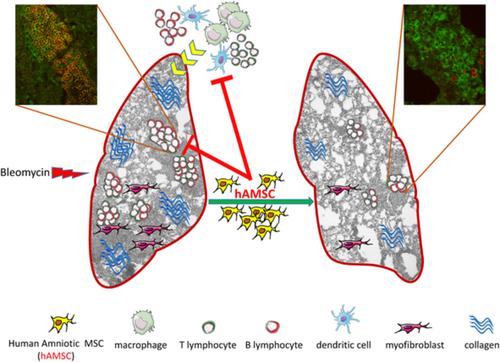当前位置:
X-MOL 学术
›
Stem Cells Transl. Med.
›
论文详情
Our official English website, www.x-mol.net, welcomes your
feedback! (Note: you will need to create a separate account there.)
Amniotic MSCs reduce pulmonary fibrosis by hampering lung B-cell recruitment, retention, and maturation.
STEM CELLS Translational Medicine ( IF 5.4 ) Pub Date : 2020-05-26 , DOI: 10.1002/sctm.20-0068 Anna Cargnoni 1 , Pietro Romele 1 , Patrizia Bonassi Signoroni 1 , Serafina Farigu 1 , Marta Magatti 1 , Elsa Vertua 1 , Ivan Toschi 2 , Valentina Cesari 2 , Antonietta R Silini 1 , Francesca R Stefani 1 , Ornella Parolini 1, 3
STEM CELLS Translational Medicine ( IF 5.4 ) Pub Date : 2020-05-26 , DOI: 10.1002/sctm.20-0068 Anna Cargnoni 1 , Pietro Romele 1 , Patrizia Bonassi Signoroni 1 , Serafina Farigu 1 , Marta Magatti 1 , Elsa Vertua 1 , Ivan Toschi 2 , Valentina Cesari 2 , Antonietta R Silini 1 , Francesca R Stefani 1 , Ornella Parolini 1, 3
Affiliation

|
Growing evidence suggests a mechanistic link between inflammation and the development and progression of fibrotic processes. Mesenchymal stromal cells derived from the human amniotic membrane (hAMSCs), which display marked immunomodulatory properties, have been shown to reduce bleomycin‐induced lung fibrosis in mice, possibly by creating a microenvironment able to limit the evolution of chronic inflammation to fibrosis. However, the ability of hAMSCs to modulate immune cells involved in bleomycin‐induced pulmonary inflammation has yet to be elucidated. Herein, we conducted a longitudinal study of the effects of hAMSCs on alveolar and lung immune cell populations upon bleomycin challenge. Immune cells collected through bronchoalveolar lavage were examined by flow cytometry, and lung tissues were used to study gene expression of markers associated with different immune cell types. We observed that hAMSCs increased lung expression of T regulatory cell marker Foxp3, increased macrophage polarization toward an anti‐inflammatory phenotype (M2), and reduced the antigen‐presentation potential of macrophages and dendritic cells. For the first time, we demonstrate that hAMSCs markedly reduce pulmonary B‐cell recruitment, retention, and maturation, and counteract the formation and expansion of intrapulmonary lymphoid aggregates. Thus, hAMSCs may hamper the self‐maintaining inflammatory condition promoted by B cells that continuously act as antigen presenting cells for proximal T lymphocytes in injured lungs. By modulating B‐cell response, hAMSCs may contribute to blunting of the chronicization of lung inflammatory processes with a consequent reduction of the progression of the fibrotic lesion.
中文翻译:

羊膜间充质干细胞通过阻碍肺B细胞募集,保留和成熟来减少肺纤维化。
越来越多的证据表明炎症与纤维化过程的发展和进程之间存在机械联系。来自人羊膜(hAMSC)的间充质基质细胞具有显着的免疫调节特性,已被证明可以减少博莱霉素诱导的小鼠肺纤维化,可能是通过建立一种微环境来限制慢性炎症向纤维化的发展。但是,hAMSC调节博来霉素诱导的肺部炎症涉及的免疫细胞的能力尚未阐明。在本文中,我们进行了博莱霉素攻击后hAMSCs对肺泡和肺免疫细胞群体的影响的纵向研究。通过流式细胞仪检查通过支气管肺泡灌洗收集的免疫细胞,肺组织用于研究与不同免疫细胞类型相关的标志物的基因表达。我们观察到,hAMSCs增加了T调节细胞标记Foxp3的肺表达,增加了巨噬细胞向抗炎表型(M2)的极化,并降低了巨噬细胞和树突状细胞的抗原呈递潜能。首次,我们证明了hAMSC显着减少了肺B细胞的募集,保留和成熟,并抵消了肺内淋巴样聚集物的形成和扩展。因此,hAMSC可能会阻碍由B细胞促进的自我维持的炎症状态,而B细胞持续充当受损肺中近端T淋巴细胞的抗原呈递细胞。通过调节B细胞反应,
更新日期:2020-05-26
中文翻译:

羊膜间充质干细胞通过阻碍肺B细胞募集,保留和成熟来减少肺纤维化。
越来越多的证据表明炎症与纤维化过程的发展和进程之间存在机械联系。来自人羊膜(hAMSC)的间充质基质细胞具有显着的免疫调节特性,已被证明可以减少博莱霉素诱导的小鼠肺纤维化,可能是通过建立一种微环境来限制慢性炎症向纤维化的发展。但是,hAMSC调节博来霉素诱导的肺部炎症涉及的免疫细胞的能力尚未阐明。在本文中,我们进行了博莱霉素攻击后hAMSCs对肺泡和肺免疫细胞群体的影响的纵向研究。通过流式细胞仪检查通过支气管肺泡灌洗收集的免疫细胞,肺组织用于研究与不同免疫细胞类型相关的标志物的基因表达。我们观察到,hAMSCs增加了T调节细胞标记Foxp3的肺表达,增加了巨噬细胞向抗炎表型(M2)的极化,并降低了巨噬细胞和树突状细胞的抗原呈递潜能。首次,我们证明了hAMSC显着减少了肺B细胞的募集,保留和成熟,并抵消了肺内淋巴样聚集物的形成和扩展。因此,hAMSC可能会阻碍由B细胞促进的自我维持的炎症状态,而B细胞持续充当受损肺中近端T淋巴细胞的抗原呈递细胞。通过调节B细胞反应,











































 京公网安备 11010802027423号
京公网安备 11010802027423号